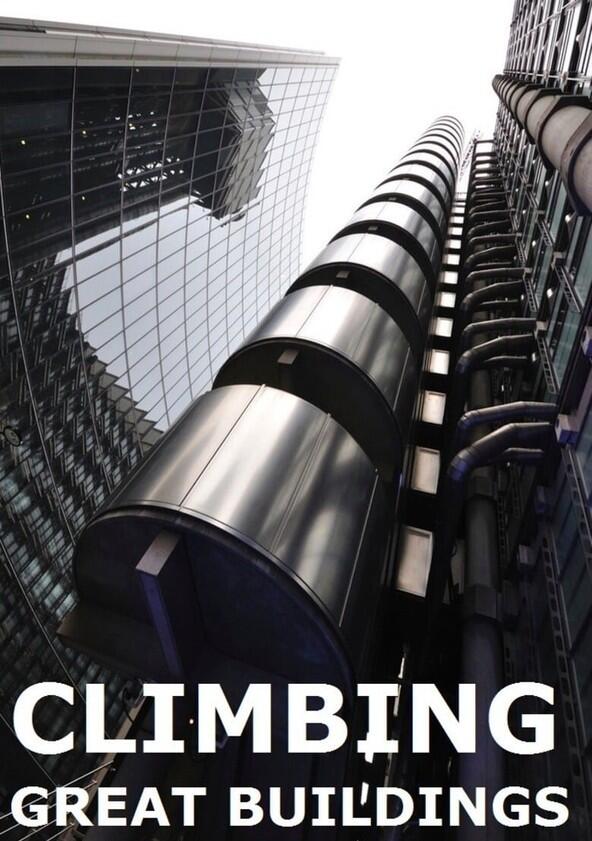Climbing Great Buildings - Season 1

Season 1

Episodes

Durham Cathedral
Dr Jonathan Foyle, architectural historian and novice climber, scales Britain's most iconic structures. Jonathan's journey begins in the north east of England at Durham Cathedral, one of the finest surviving examples of Norman architecture in the UK. Jonathan, who has never climbed before, is aided by Lucy Creamer, one of Britain's top climbers, as he conquers his fears to scale over 140 feet to the top of Durham Cathedral to investigate how the Normans revolutionised building in this country. On his climbs, he comes face to face with the crumbling 1000-year-old stone with oyster shells hiding in the mortar, discovers carved stone arches influenced by the art of the Middle East and he braves a tightrope nearly 100 feet above the nave, to get a closer look at the revolutionary and beautiful stone ceiling.

Lincoln Cathedral
The next step of Jonathan's journey takes him to Lincoln Cathedral, built in 1183. Once the tallest building in Britain, Lincoln Cathedral is one of the finest examples of gothic architecture in Britain. With unprecedented access, Jonathan - aided by top climber Lucy Creamer - scales the cathedral to reveal the skill and innovation of the medieval gothic builders and craftsmen. On his climbs, Jonathan is suspended 100ft above the nave to get a unique cinematic view of the immense Dean's Eye stained glass window; meets an evil imp and a riot of monsters; and faces his biggest climbing challenge yet as he scales the exterior walls of the cathedral's central tower - all 272 feet of it.

Caernarfon Castle
Jonathan's journey takes him to Caernarfon Castle, built in 1283 and one of the most magnificent examples of medieval castle building in Britain. Jonathan, aided by top British climber Lucy Creamer, tests his climbing skills to reveal the secrets of this monster of a castle's construction, and what it would have been like for anyone foolhardy enough to attack it. On his climbs, he scales over 100 feet up the majestic Eagle Tower to investigate how the architect behind Caernarfon revolutionised castle building in Britain; he discovers how the castle's design and decoration were inspired by the ancient Roman town of Constantinople; and he tests the limits of his courage zip-wiring high above the castle before abseiling down the King's Gate to investigate the fortified main entrance, which housed an innovation so lethal that it's been dubbed a medieval machine-gun.

New College
Jonathan's journey takes him to New College in Oxford. Built in 1379, this college set the blueprint for universities all over the world for the next 600 years. Jonathan climbs the dreaming spires of the College to investigate how the devastation of the Black Death led to an architectural innovation. He tests his newly acquired climbing skills by scaling almost 100 feet to reveal how the enduring symbol of university life - the quadrangle - originated here. On his climbs, he discovers the bishop whose vision it was, and sees how he literally left his mark all over the college in a medieval PR stunt; discovers carvings of English folk tales in the chapel; and traverses a sheer drop of 80 feet to explore how a new glazing technique, known as 'yellow stain', allowed New College to create some of the most magnificent medieval stained glass in the country.

Layer Marney Tower
Jonathan's journey takes him to Layer Marney Tower, a Tudor skyscraper nestled in the countryside near Colchester in Essex. With unprecedented access to Layer Marney, Jonathan, aided by top climber Lucy Creamer, scales the building to reveal the innovations of the Tudor builders and craftsmen. On his adventure, Jonathan scales the highest and most majestic Tudor gatehouse in Britain to investigate why brick, an art form that died out with the Roman Empire, suddenly became the must-have building material for Tudor nobles. As he climbs all over the building, he walks a tightrope between the beams of a 500-year-old roof to investigate how Layer Marney's history is literally carved into the building; exposes the cunning Tudor tricks of the trade that make the house appear even more opulent than it actually is; and reveals the connection between parmesan cheese and the beautifully ornate terracotta.

Burghley House
Jonathan's journey takes him to Burghley House in Lincolnshire. Built to impress Queen Elizabeth I on her many trips around the country, it's the finest example of an Elizabethan house in Britain. With unprecedented access to Burghley, Jonathan, aided by champion climber Lucy Creamer, climbs the building, to reveal the innovations of the Elizabethan builders and craftsmen. On his adventures, Jonathan scales up to the roof of Burghley to reveal a unique playground of hidden ornate sculpture where royalty and ambassadors were entertained. He also zips 80 feet across the central courtyard to decipher the scores of mysterious symbols that adorn the building, and scales over a hundred feet to come face-to-face with a one-handed clock. Finally, Jonathan reveals why, although the house was built to accommodate Elizabeth I and her court, she never even set eyes on it.

St Paul's Cathedral
Jonathan's journey celebrating Britain's architecture takes him to St Paul's Cathedral in London. If one structure captures the spirit of London, this is it. Beautifully crafted and designed by the great Sir Christopher Wren, it is simply stunning in its stature, with its iconic dome that has dominated London's skyline for over 300 years. With unprecedented access to secret parts of St Paul's, Jonathan, aided by champion climber Lucy Creamer, climbs over 300 feet to investigate the innovations and tricks of the trade that architectural illusionist Christopher Wren employed to create this magnificent cathedral. He tests the limits of his courage to abseil over 220 feet straight down the centre of the dome from the cupola to get a completely unique view of St Paul's. He reveals how not everything at St Paul's is at it seems, as he uncovers the magic behind the greatest of Wren's architectural tricks.

Blenheim Palace
Jonathan's journey celebrating British architecture takes him to the epitome of the English stately home: Blenheim Palace in Oxfordshire. Built in the early 1700s as a reward for the Duke of Marlborough's defeat of King Louis XIV of France, it's one of the finest examples of English Baroque buildings in the country. With unprecedented access to Blenheim Palace, aided by champion climber Lucy Creamer, Jonathan scales the building to investigate the innovations and techniques used to construct it and to decipher the stories and propaganda carved all over the building. He climbs over 100 feet to reveal the story of how a bawdy playwright, a brave general and his strong-willed wife combined and clashed to create this most audacious masterpiece. He zips across the courtyard to see how the duke's epic victory is celebrated in stone through flamboyant and satirical sculpture, and he dangles precariously.

Clifton Suspension Bridge
Jonathan's journey takes him to the Clifton Suspension Bridge in Bristol. Begun in 1835 by the great engineer Isambard Kingdom Brunel when he was only 24 years old, it is one of the greatest feats of Victorian engineering in the world. With unprecedented access to the bridge, aided by champion climber Lucy Creamer, Jonathan scales all over to the bridge to investigate the innovations and techniques used to build this incredible structure inspired by £1000 from a wine importer. Jonathan climbs over 300 feet to investigate the revolutionary design and perches atop the massive and revolutionary chains that make it all possible. He descends 35 feet to discover Brunel's massive secret chambers in the towers that remained undiscovered until 2002, and he hangs exposed 245 feet above the river Avon to reveal the Victorian engineering which prevents disaster by expanding and contracting, just as Brunel devised.

St Pancras
Jonathan's journey takes him to King's Cross St Pancras, a masterpiece of Victorian design, widely regarded as London's most stunning and romantic station. With unprecedented access to St Pancras, aided by champion climber Lucy Creamer, Jonathan scales all over the buildings to investigate the innovations and techniques used to construct both the train terminal and the elegant Midland Hotel. On the Midland Hotel, Jonathan climbs over 240 feet up the immense clock tower to explain how Britain had different time zones until the advent of stations like St Pancras. He discovers water-powered elevators, why penthouses used to be on the ground floor, and how the hotel was almost doomed to failure by only providing nine bathrooms for 400 bedrooms.And in the station he scales the incredible glass span roof that crosses the main terminal - the largest of its kind in the world.

Glasgow School of Art
Jonathan's journey takes him to the Glasgow School of Art, built from 1897 by artist Charles Rennie Mackintosh. The school is considered to be one of Britain's most controversial, challenging and celebrated buildings. With unprecedented access, Jonathan, aided by top climber Lucy Creamer, scales the school to reveal the myriad of influences, from medieval castles to Japanese heraldry, that Mackintosh used to create his modernist masterpiece. On his architectural treasure hunt, Jonathan scales over 90 feet to reveal how the building is modelled on a baronial castle, and how Mackintosh pokes fun at traditional architecture. He also investigates how nature and the Industrial Revolution combine when he explores one of the greatest rooms in Europe - the Mackintosh Library.

Royal Liver Building
Jonathan Foyle's journey takes him to the Liver Building in Liverpool. Built from 1908, this behemoth in concrete was Britain's first skyscraper that influenced buildings all over the world. On his climbs Jonathan, aided by top climber Lucy Creamer, scales over 250 feet to reveal how this granite building isn't quite what it seems and investigates how a concrete boat paved the way for this immense skyscraper. He climbs up a disused lift shaft to literally get under the skin of this groundbreaking construction; comes face-to-face with the biggest clock in Britain; and tests the limits of his courage to traverse over a sheer drop of over 200 feet to get up close and personal with a couple of beautiful birds.

Coventry Cathedral

Lloyd's Building

Imperial War Museum
Recently Updated Shows

Beyond the Gates
Beyond the Gates is set in a leafy Maryland suburb just outside of Washington D.C., and in one the most affluent African American counties in the United States. Here you'll find a posh gated community with winding tree-lined streets and luxurious mansions to call home. At the center of this community are the Duprees, a powerful and prestigious multi-generational family that is the very definition of Black royalty. But behind these pristine walls and lush, manicured gardens are juicy secrets and scandals waiting to be uncovered. And those that live outside these gates are watching closely. These are the places where our characters live, love, work and play. Those who have "made it" and those who haven't are all trying to navigate life … and some with more grace than others.

WWE Premium Live Events
Beginning with the 2014 Extreme Rules Pay-Per-View on 4 May 2014 the WWE began airing all of their Wrestling Pay-Per-Views exclusively on the WWE Network. Subscribers who pay the $9.95 monthly fee will be able to view any Pay-Per-Views past, present and in the future exclusively on the WWE Network at no additional charge as long as their monthly fees are paid up-to-date.

Peacemaker
The series will explore the origins of the Peacemaker, a man who believes in peace at any cost - no matter how many people he has to kill to get it.

The Ministry of Time
The Ministry of Time, a newly established government department, is gathering ‘expats' from across history in an experiment to test the viability of time-travel. Commander Graham Gore (an officer on Sir John Franklin's doomed 1845 Arctic expedition) is one such figure rescued from certain death – alongside an army captain from the fields of the Somme, a plague victim from the 1600s, a widow from revolutionary France, and a soldier from the seventeenth century.
The expats are placed with 21st century liaisons, known as 'bridges', in unlikely flatshares. Gore has to learn about contemporary life from scratch: from air travel to industrial warfare, from feminism to Spotify, from cinema to indoor plumbing; and he must negotiate cohabiting with the ambitious modern woman who works as his bridge. After an awkward beginning, the pair start to find pleasure and comfort in each other's company, developing a relationship that is simultaneously tender, intense and profoundly unprofessional; and the expats, adrift in a new era, form friendships that ground and support them in the lonely 21st century, where they have outlived everyone they ever knew and loved.
When a deeper conspiracy at the Ministry begins to reveal itself, the bridge must reckon with what she does next. Will she save or sacrifice the exiled misfits she has come to care for so deeply?